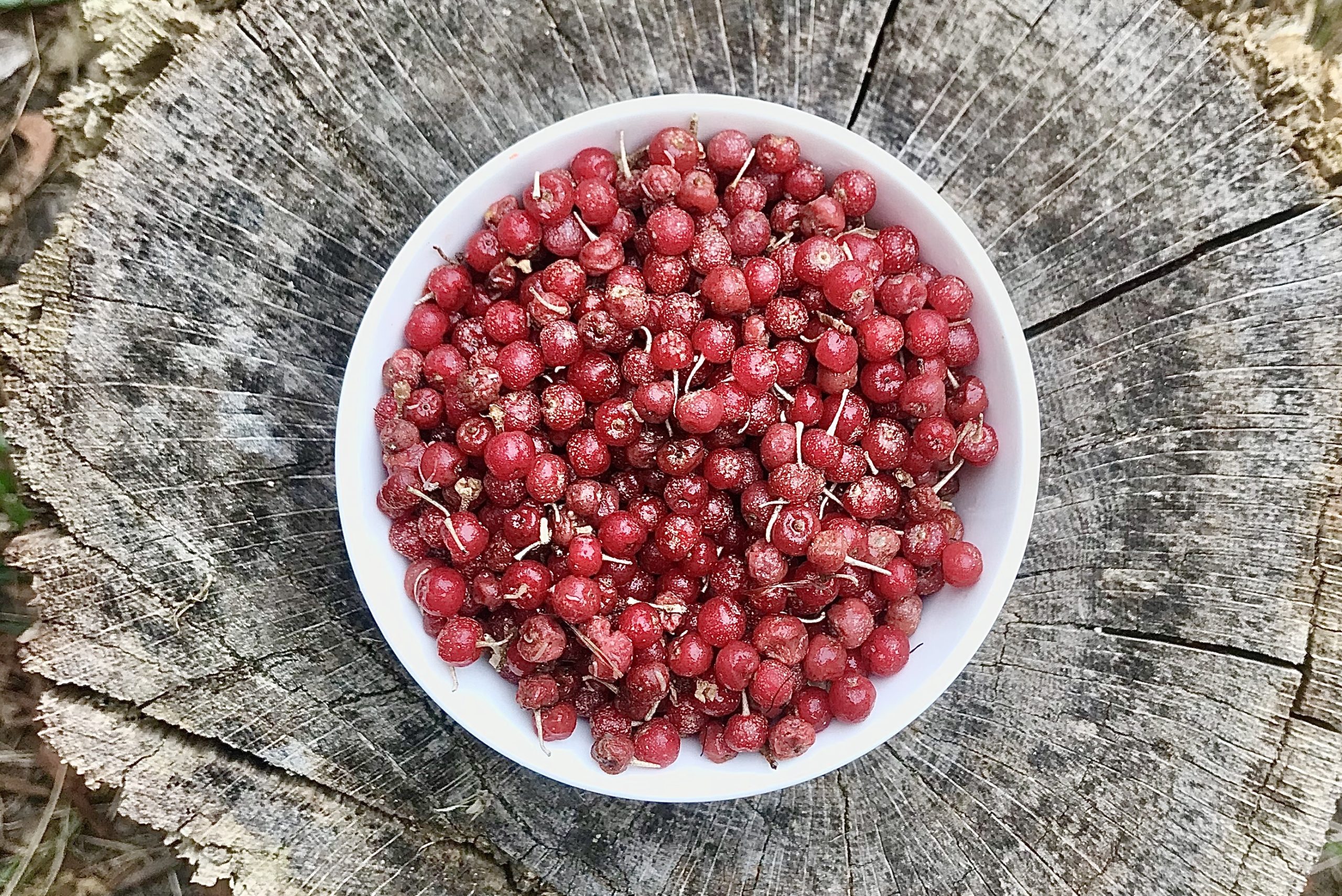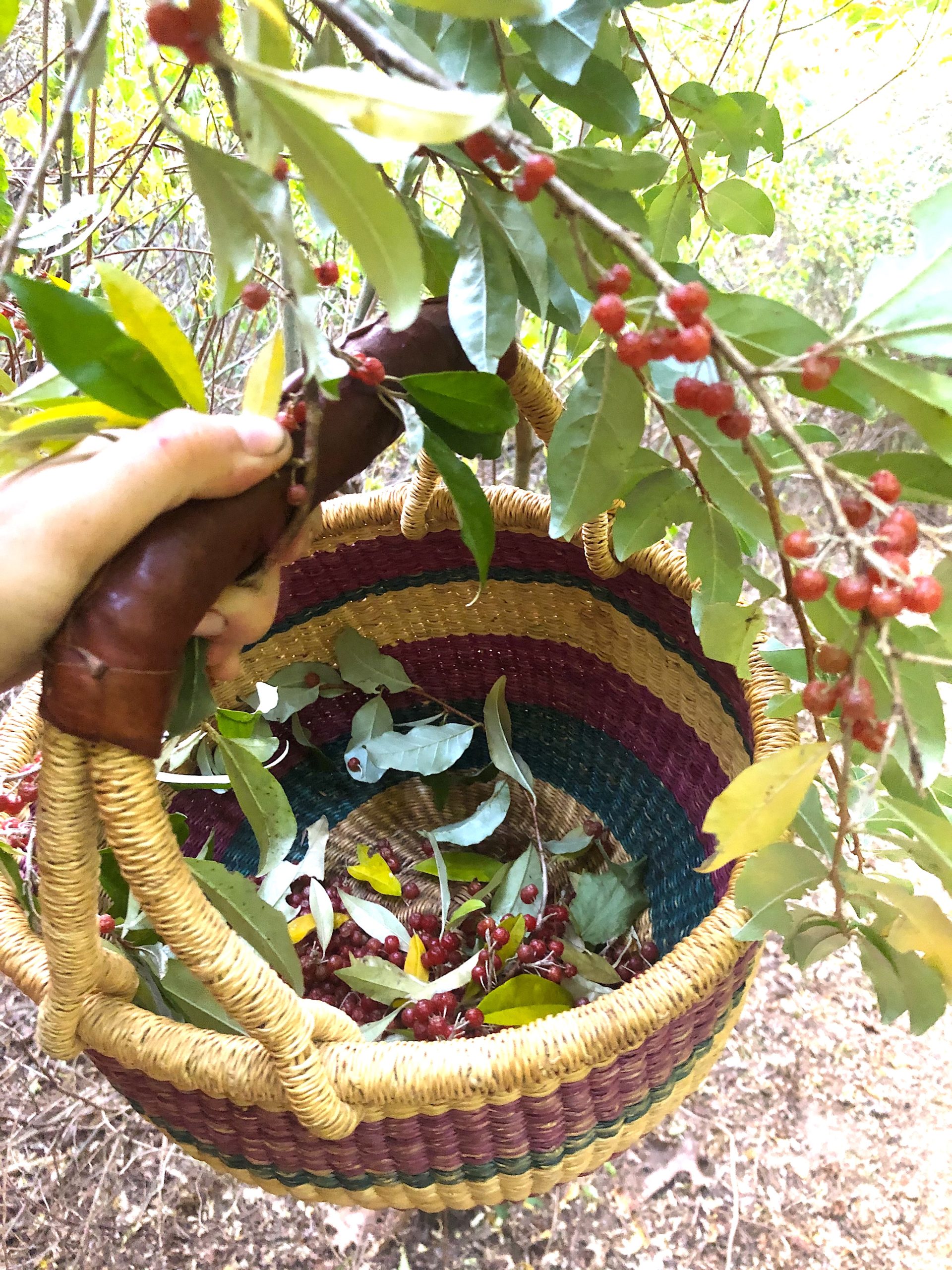OCTOBER – AUTUMN OLIVE

Olives?… like Plantain (our September plant of the month), we find on our hands yet another unexpected plant on a New England conservation cooking post! But yet again, these are certainly not the salty, rich “olives” you are familiar with. No, our sweet and sour “Autumn Olives” (Elaeagnus umbellata) are not much like an olive at all.
Autumn Olive is a deciduous, woody shrub, native to Asia and introduced in the early 1800s for landscaping, wildlife habitat, and erosion control. The plant is now so prolific it is identified as invasive, as it’s made its home throughout the Northeast. Much loved by our feathered friends, Autumn Olive easily spreads as birds ingest and later drop their seeds throughout the landscape. Because they are drought-tolerant and nitrogen-fixing, the plant too easily outcompetes surrounding indigenous species. Often, you’ll find this hearty shrub along forest trails and the edges of old fields, the bottoms of each silvery leaf and flecked stem sparkling in the sun. Known also as the “Japanese Silverberry”, the tiny, juicy berries of the plant are also spotted and lustrous, turning bright red when ripe (Sep-Nov).

Not only are the berries quite beautiful against the Autumn landscape, but they are also just as delicious! They also happen to be my personal favorite item to forage come Fall. The berries themselves are known to be rich in antioxidants Vitamins A, C, E, and lycopene (18x more than tomatoes!), with a unique balance of sweetness and tartness. They make for a perfect syrup, juice, jam, fruit leather and tart base.
Have I got your attention? Good! Because now is the time to grab your basket and head for the fields + forests on your Autumn Olive quest! As the weather turns colder the berries will turn sweeter. So, find yourself a good stand of shrubs and get to know them over the coming weeks. Autumn Olives are quite easy to harvest — simply hold a basket beneath the branches and “tickle” the berries loose from the branches.
(*Pictured on the left is our Autumn Olive harvest this fall at Noquochoke Conservation Area. We’ve found that our usual harvesting spots are less abundant than usual this year.)
Should you find yourself even a single abundant shrub, you’re in luck. You can easily gather enough berries to last you through the winter (which is always the goal in our household). But now, what to do with them? Well first of course, eat them fresh! The astringency followed by sweetness will delight your palette. But the fresh fruit will soon begin to ferment, so it’s best to preserve them in some way. The simplest and most versatile way that I’ve found of preserving this bountiful fruit is making a simple syrup. The steps are quite unscientific, so you can find the precise ratios that work best for your pallet and uses!
- Collect your berries. Remove stems and twigs (without driving yourself crazy!) and give your berries a good rinse.
- Add berries to a pot and cover with water by an inch or so. Simmer for approx. 15 minutes, mashing the berries with a potato masher as they warm up.
- Turn off the heat and let the watery berry mash cool.
- Pour your mash through a strainer, smashing the berries well against the strainer to get as much pulp as possible. You can compost your pulp, as the boiling process will kill the seeds, preventing them from propogating.
- Return your thick, strained liquid to a pot and bring to a low simmer. Reduce / cook off water until you have a thick consistency.
- Add sugar (and lemon, if you’d like) to taste, and cook for 5-10 minutes more. Let cool, then pour into a jar for storage.
Autumn Olive syrup can tend to separate, which isn’t a problem — simply stir your syrup. It won’t last indefinitely in the refrigerator, so I suggest bottling your syrup up in pint jars and freezing them for use throughout the winter months.
Autumn Olive syrup is simply AMAZING drizzled onto pancakes and mixed into plain yogurt. So delicious, that I personally have not felt the call to experiment with any other Autumn Olive recipes! But should you feel the creative impetus, check out the following links for more ways to enjoy this abundant, local fruit:
- Autumn Olive Tart
- Autumn Olive Fruit Leather
- Autumn Olive Ketchup
- Autumn Olive Chutney
- Autumn Olive Ice cream
Happy fall & happy foraging, friends!

Carissa Wills-Demello
Author

